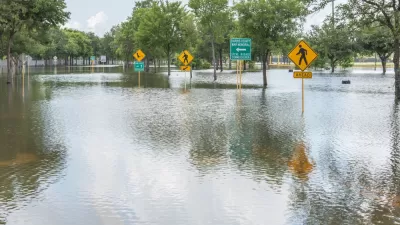History shows that there's more than one way to control flooding, but the best ideas are also urban amenities.

After Hurricane Harvey's destruction, but before money for rebuilding pours in, Jose Solis takes a page in the Houston Chronicle to consider how two cities responded to major floods in the fairly distant past.
"The histories of San Antonio and Los Angeles," Solis writes, "provide strong arguments for why design should play an essential role in developing new infrastructure and a cautionary tale for what happens when it is ignored."
Both Los Angeles and San Antonio experienced major flooding in the 1920s and '30s that brought a great deal of federal funding for major infrastructure to prevent future losses. Los Angeles, using a strategy typical of both the urbanism of the era and of the city itself, buried the Los Angeles River, replacing it with an effective but joyless concrete channel; San Antonio built Riverwalk, which works as a flood control device but also as an amenity for residents and a huge tourist draw.
History has been much kinder to Riverwalk, and Los Angeles is preparing to spend a great deal of money to remake the LA River into something more like it. (Houston's neighbor, New Orleans, also embraced the idea of amenity-as-flood-control after its own catastrophes.)
Solis praises New York City's post-Sandy Rebuild by Design competition as something that "evolved into a broader initiative for rebuilding cities to be more resilient" and suggests that Houston initiate something similar.
"Rebuild by Design," Solis continues, "provides a blueprint for how Houston can attract leading thinkers to develop solutions that will not only protect us during future floods, but let people enjoy living here for all the times between."
FULL STORY: As Houston rebuilds, we need amenities, not eyesores

Maui's Vacation Rental Debate Turns Ugly
Verbal attacks, misinformation campaigns and fistfights plague a high-stakes debate to convert thousands of vacation rentals into long-term housing.

Planetizen Federal Action Tracker
A weekly monitor of how Trump’s orders and actions are impacting planners and planning in America.

In Urban Planning, AI Prompting Could be the New Design Thinking
Creativity has long been key to great urban design. What if we see AI as our new creative partner?

Cal Fire Chatbot Fails to Answer Basic Questions
An AI chatbot designed to provide information about wildfires can’t answer questions about evacuation orders, among other problems.

What Happens if Trump Kills Section 8?
The Trump admin aims to slash federal rental aid by nearly half and shift distribution to states. Experts warn this could spike homelessness and destabilize communities nationwide.

Sean Duffy Targets Rainbow Crosswalks in Road Safety Efforts
Despite evidence that colorful crosswalks actually improve intersection safety — and the lack of almost any crosswalks at all on the nation’s most dangerous arterial roads — U.S. Transportation Secretary Duffy is calling on states to remove them.
Urban Design for Planners 1: Software Tools
This six-course series explores essential urban design concepts using open source software and equips planners with the tools they need to participate fully in the urban design process.
Planning for Universal Design
Learn the tools for implementing Universal Design in planning regulations.
Appalachian Highlands Housing Partners
Gallatin County Department of Planning & Community Development
Heyer Gruel & Associates PA
Mpact (founded as Rail~Volution)
City of Camden Redevelopment Agency
City of Astoria
City of Portland
City of Laramie





























